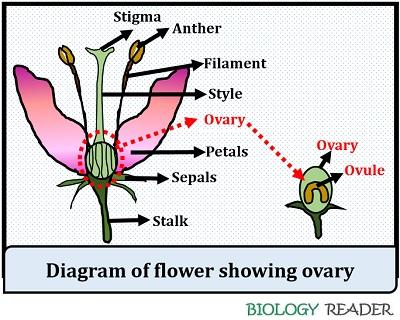Ovary culture is the in-vitro technique carried outside, i.e. on a suitable nutrient medium to grow new haploid plants by taking an unpollinated flower. The ovary culture process is called gynogenesis because an ovary is a female reproductive part called gynoecium.
Gynogenesis was first studied by a scientist named San Noem in the year 1976. For the gynogenesis, we can select either pollinated or un-pollinated flower. A pollinated flower is cultured into the simple nutrient medium, whereas an un-pollinated flower is cultured on the special medium added with synthetic auxins and sucrose.
The ovary culture method provides an important tool to study the fundamental growth and development of an embryo and fruit’s physiology. You will get to know the meaning, principle, protocol, importance, and limitations of the ovary culture method in this context.
Content: Ovary Culture
Meaning of Ovary Culture
Ovary culture is defined as the in-vitro culturing method, which makes the use of ovaries that are excised from the pollinated or un-pollinated flowers aseptically and allowed to culture in an appropriate nutrient medium under controlled conditions. It produces haploid plantlets by fertilising an egg-cell or megaspore either through embryogenesis or regeneration from callus.
What is Ovary?
An ovary is a floral part, which typically represents the female reproductive part and also called gynoecium. It is one of the components of carpel that we can see in the image given below. Carpel includes a long style, terminal stigma and ovule within the ovary.
 Style and Stigma: The ovary is the basal body from which a long and slender tube, i.e. style originates, and a stigma is terminally present on the style.
Style and Stigma: The ovary is the basal body from which a long and slender tube, i.e. style originates, and a stigma is terminally present on the style.
Ovule: Within the ovary, an ovule (also called megasporangium) carries megaspore or egg-cell. The integuments of an ovary encase the egg-cell. The egg cell goes through fertilization, after which a zygote forms that later develops into a mature embryo.
Principle
The principle of gynogenesis is based on the regeneration principle, in which an ovary can regenerate into a fully differentiated plant. In the ovary culture, the flowers are excised from the plant either in pollinated or non-pollinated stage. Then, the ovary is removed from the flower’s pistil. The ovary possesses an ovule (a female reproductive part of a flower), which can develop haploid plantlets by the growth on nutrient medium under controlled conditions.
Method of Ovary Culture
Gynogenesis includes the following steps:

- First, collect the open flowers from a healthy plant and keep it in a sterilized zip-lock bag.
- Wash the flowers with the distilled water.
- Then, dip the flowers into a 5% Teepol solution for 10 minutes.
- Rewash the flowers with the distilled water.
- Bring the flowers to the laminar airflow chamber.
- Then subject the flowers to surface-sterilization by immersing them in a 5% sodium hypochlorite solution for 5-7 minutes. Again wash the flowers with the distilled water.
- To a sterile Petri-plate, transfer the surface-sterilized flower, and by using a sharp scalpel dissect the calyx, petal, and other filaments etc. to separate the ovary.
- Then, the ovary can be cultured either through induction or regeneration process. In induction, the ovaries float over the liquid medium. In contrast, the ovaries grow on the solid nutrient medium in the regeneration process.
- Incubate the cultures for 16 hours at 25 degrees C. For ovary regeneration, keep the culture plates in a daylight regime by using a fluorescent lamp. Place the culture tubes in the dark for the induction process.
- After 2 weeks, haploid plantlets will grow either through embryogenesis or through plant regeneration from callus.
Importance
Ovary culture helps in the study of the early stages of embryo development. Gynogenesis also helps in the study of fruit development and its physiology, including maturation. From the un-pollinated pistil culture, the effect of phytohormones on the parthenocarpic fruit can be studied.
Role of floral organs can be studied, which plays a significant role in fruit development. Gynogenesis also helps in inducing polyembryony, in which many shoots can be developed instead of single plantlet. Ovary culture also explains the in-vitro pollination and seed formation method. An ovary’s culture from the apomictic plant can help us understand the stimulus provided by pollination.
As apomistic plant (fertilization absent) and the pollination alone stimulates the ovary growth and seed development. Ovary culture also helps us understand the hybridization process to obtain hybrid varieties of seedlings by crossing over interspecific and intergenic species.
Limitations
The frequency of haploid production is very low in ovary culture as only 1-5% of the responding ovaries are there. This technique requires high technical skills and management. Gynogenesis can be employed only in limited species, for example, wheat, rice, maize, sugar beet etc.
Thanks for sharing all of your experiences!